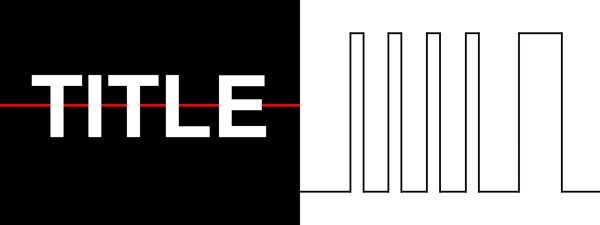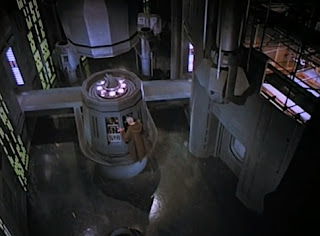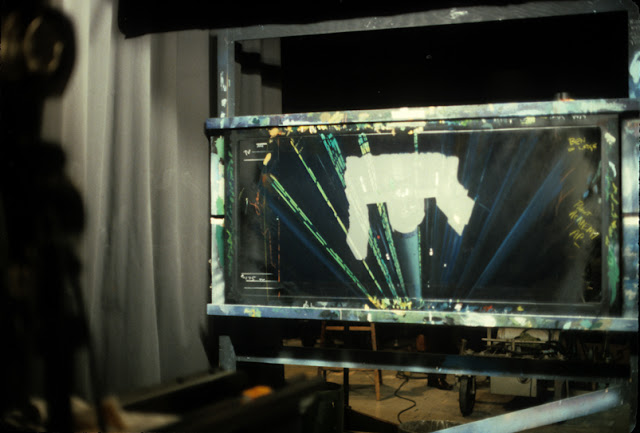Yes, it was an old pre colour mixing desk inlay set-up (though it could mix colour signals, just not key by colour). Just meant it as a rough description of how it can be done.^^^That's a lumakey as opposed to a chromakey. The white and black act like a matte/mask.
-
Welcome! The TrekBBS is the number one place to chat about Star Trek with like-minded fans.
If you are not already a member then please register an account and join in the discussion!
You are using an out of date browser. It may not display this or other websites correctly.
You should upgrade or use an alternative browser.
You should upgrade or use an alternative browser.
How was Star Trek edited back in the '60s?
- Thread starter Shalashaska
- Start date
In video "keying" means switching. Let's say that the white letters on a black background are the key source. If we look at the line in the middle of the picture (marked in red), the luminance (brightness) of the line rises and falls like the line shown on the right.

The composite is set up with two images, A & B, and switched back and forth between the two as the key signal rises and falls. Low go with A (say a background image) and high go with B (say a color generator set to yellow). The result is a background image with yellow letters on it. As all the images are scanned line-by-line from top to bottom, a complete image is formed. Wipes are pretty much the same thing, only the key signal is created electronically. A square wave will give you horizontal or vertical wipes, or a box wipe. A sine wave will give you a circle wipe. A triangle wave will give you diagonal wipes or a diamond wipe, and so on.
Chroma key ("color" key) can use any color, but the background is typically blue, probably because of the tradition established by the popular bluescreen used in film. Of the three colors that make up a video image (red, green, blue) blue makes up the lowest percentage of the color mix. When digital imaging came along the popular color became green because green makes up the highest percentage of the color mix, and thus produces the cleanest keys.
The same matting/masking technique mentioned upthread is also how titles are made on film. So optical houses often made titles as well as any optical artwork and effects that were needed.

The composite is set up with two images, A & B, and switched back and forth between the two as the key signal rises and falls. Low go with A (say a background image) and high go with B (say a color generator set to yellow). The result is a background image with yellow letters on it. As all the images are scanned line-by-line from top to bottom, a complete image is formed. Wipes are pretty much the same thing, only the key signal is created electronically. A square wave will give you horizontal or vertical wipes, or a box wipe. A sine wave will give you a circle wipe. A triangle wave will give you diagonal wipes or a diamond wipe, and so on.
Chroma key ("color" key) can use any color, but the background is typically blue, probably because of the tradition established by the popular bluescreen used in film. Of the three colors that make up a video image (red, green, blue) blue makes up the lowest percentage of the color mix. When digital imaging came along the popular color became green because green makes up the highest percentage of the color mix, and thus produces the cleanest keys.
The same matting/masking technique mentioned upthread is also how titles are made on film. So optical houses often made titles as well as any optical artwork and effects that were needed.
Here's a documentary about matte painting. (The one I was looking for was from the 80s, but this one probably covers the same material.)
Interesting. I didn't know it was that widely used. The only time I'd really seen it demonstrated was in an old Star Wars documentary from the 80's where they showed how they made the tractor beam control shot.


Which is the usual sign of a fantastic effectI didn't know it was that widely used.

Star Wars had a bunch of matte paintings:
http://sploid.gizmodo.com/the-amazing-matte-paintings-from-star-wars-and-their-cr-1680372651
http://imgur.com/gallery/mLraW
Not quite the same thing, but a similar technique: at the Uni TV station in the late 80s we could composite shots by pointing a third camera at a black/white board to select which of the other two cameras to put on-screen.
Draw a white chalk ray beam (of varying intensity) on the black, and you could put a laser that flares and fades onto the screen by changing the sensitivity of the overlay camera.
This is video, but the same rough analogue techniques that were used on film.
That was how they did mattes in early Doctor Who. One of the most interesting examples was in the main titles in the Patrick Troughton years, where there's this weird irregular wipe of the image from the title to a shot of Troughton's face. The way they did it is fascinating -- they got an irregular block of styrofoam, started it out so that it was fully lit from above and appeared all white to the camera, then rotated it so that the bumps cast lengthening shadows until the whole screen was black, and they fed the two different images into the white and black areas. Amazing ingenuity.
Indeed, I worked out that the equipment we had at Nexus could do more than simple wipes after reading a piece Jeremy Bentham had written in Space and Time explaining how the Troughton-era inlay effects were done.That was how they did mattes in early Doctor Who. One of the most interesting examples was in the main titles in the Patrick Troughton years, where there's this weird irregular wipe of the image from the title to a shot of Troughton's face. The way they did it is fascinating -- they got an irregular block of styrofoam, started it out so that it was fully lit from above and appeared all white to the camera, then rotated it so that the bumps cast lengthening shadows until the whole screen was black, and they fed the two different images into the white and black areas. Amazing ingenuity.
Lumakeying is a technique I used all over the place in the finale of "Tressaurian", notably on the black hole and to create the slot-mask particle gags. The black and white "mattes" you see in this video are all masks for lumakeying (others, like the gas jets, are just double exposed in (and sometimes tinted) at various densities to create various gas elements).
A side note on this, but I'm rewatching the original Monty Python TV series off DVD. It's noticeable that season one (69/70) uses back projection for fake backdrops/news screens, but by season two it's blue screen CSO ( with occasional jokes pointing that out).
Neat! I think maybe a little harder to follow than necessary, but a good summation.Here's a very informative vid that showed up on Facebook on how special effects were composited on an optical printer in "the old days". It shows how Star Wars-era effects were composited, but it's not reeally any different from the 60s.
Lumakeying is a technique I used all over the place in the finale of "Tressaurian"
That's not actually lumakeying, that's alpha channels ("mattes').
Here's a very informative vid that showed up on Facebook on how special effects were composited on an optical printer in "the old days". It shows how Star Wars-era effects were composited, but it's not reeally any different from the 60s.
Good video, but convoluted. (Confusing for the novice.) That's why when I explained it up-thread I covered the two basic concepts:
- Blue items are dark when viewed through a red filter (or under red light), while blue items are clear or "white" under a blue filter. And vice versa (red is dark under a blue filter, etc.) This is the same mechanism that makes anaglyphic (red/blue) 3D glasses work. This is also the mechanism used for all color separation from offset printing to video cameras. (Some of the separation prisms in old cameras were huge. Nowadays we have cameras with Bayesian filters and other patterns over a single sensor, but the filtering for color separation is the same.)
- By combining a positive and negative of the separations, one can generate a complete matte for masking the images. And that is what allows one to "jigsaw" the parts together without the ghostly transparency of uncontrolled multiple exposures.
Since when are motion picture type mattes "alpha channels"?That's not actually lumakeying, that's alpha channels ("mattes').
Those literally are black and white matte passes with no alpha channel information. Sure, the software reads that and generates its own alpha channel. So of course it's not a 1:1 match to a video hardware lumakey, but the filter in question behaves like one.
Film is typically edited by physically splicing pieces of film together, typically using overlap splicing and film cement, unless the film is on a polyester (e.g., ESTAR) base. Normally, the editor works on a "work print"; the negatives are not cut until the final cut of the film is approved in work print, and all the optical compositing is complete, and then the negatives are cut to match the work print, usually using what's called an "A/B Roll" technique to keep the splices from showing up on hard cuts, and to make wipes and dissolves possible.
Film can be edited on a flatbed editing bench (either with the film on horizontal plates or on spindle stands called "rewinds"), with a prismatic viewer and a synchronizer, or on a Moviola, or on a combination of the two.
Film can be edited on a flatbed editing bench (either with the film on horizontal plates or on spindle stands called "rewinds"), with a prismatic viewer and a synchronizer, or on a Moviola, or on a combination of the two.
Me, I had a little super-8 editor with a two 50-foot reels, a 3" screen, a guillotine cutter and little pieces of clear tape.
Me too!! I was so excited when that splicing tape came on the market -- it may not have been perfect, but it was SO SO much less hassle than the glue.

I shot standard-8. With a spring-driven camera that had to have its mainspring cranked back up every 30 seconds, and the film (double-double-perf 16mm, on 25' open daylight-loading spools, split to 8mm after processing) turned over, preferably in a changing bag, after exposing one side. And my editing bench and my projector handle both standard-8 and super-8. I eventually upgraded from a tape splicer to a cement splicer (yes, they were made that small).Me, I had a little super-8 editor with a two 50-foot reels, a 3" screen, a guillotine cutter and little pieces of clear tape.
A "rewind" style 16mm or 35mm (or larger) sound editing bench looks and works much like the consumer 8mm models, except that it has a synchronizer, and the rewinds can handle multiple reels (usually as many as there are channels in the synchronizer).
Oh, and Happy Apollo Day, everybody.
Well, whether you are doing Chroma keying, luma keying, or matte's, you also need a good system that can handle the colors separately and good timing. I was just watching a DVD of The Midnight Special the other night, and on one of the videos, because it was just one person and a guitar, the director was chroma keying the singer so that they were on screen the whole time, but then the director could also get close-ups of the hands strumming the guitar, etc. But you could tell that the chroma key was being done with composite video and the green background, while mostly gone was still leaking through, mixing with composite dot crawl.
But then you watch an old film like 1956 The Ten Commandments, and there are traces of chroma keying all over the place (Just watch the scene where the Pharoah and I think Moses are looking out on the crowd pulling the Egyptian statue through the streets, you can see the edge of the blue screen matte by their feet, and even more blue screen matte lines around the statue as the scene contains 3 different layers).
But then you watch an old film like 1956 The Ten Commandments, and there are traces of chroma keying all over the place (Just watch the scene where the Pharoah and I think Moses are looking out on the crowd pulling the Egyptian statue through the streets, you can see the edge of the blue screen matte by their feet, and even more blue screen matte lines around the statue as the scene contains 3 different layers).
Bluescreen was never an ideal matte process, because the matte borders didn't always match perfectly, due to certain limitations in the technique. So it didn't work well for things that had soft edges like hair or fur, or things that were moving quickly and had motion blur. Disney's sodium matte process gave sharper matte edges and cleaner composites, but it relied on a unique prism that nobody was ever able to duplicate, so it didn't get as widespread use as bluescreens. Alfred Hitchcock rented the sodium-matte equipment from Disney for The Birds because bluescreen couldn't handle the birds' fast-moving wings and feathery textures and such.
Similar threads
- Replies
- 32
- Views
- 2K
- Replies
- 31
- Views
- 2K
- Replies
- 25
- Views
- 10K
If you are not already a member then please register an account and join in the discussion!
